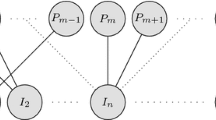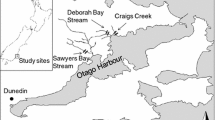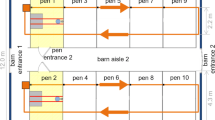Summary
The distribution of goldfish differing in competitive status approximately mimicked that expected for the ideal free distribution but with slightly too many fish in the poorer site. As predicted by phenotype-limited game theory models of dispersion, the mean rank of fish in a site varied inversely with the number of fish, both in the high and low input sites, and there was no correlation between competitive rank and time spent in the better site. The intake was higher for each individual in the high input site than in the low input site, showing that the distribution was not an exact evolutionarily stable strategy. We suggest that the deviation is due to sampling or perceptual constraints. Analysis of other studies with continous input shows that the discrepancy from the theoretical expectation increases with input ratio.
Similar content being viewed by others
References
Abrahams MV (1986) Patch choice under perceptual constraints: a cause for deviations from an ideal free distribution. Behav Ecol Sociobiol 19:409–415
Courtney SP, Parker GA (1985) Mating behaviour of the blue tiger butterfly (Tarucus theophrastus): competitive matesearching when not all females are captured. Behav Ecol Sociobiol 17:213–221
Davies NB, Halliday TR (1979) Competitive mate searching in common toads Bufo bufo. Anim Behav 27:1253–1267
Fretwell SD, Lucas HL (1970) On territorial behaviour and other factors influencing habitat distribution in birds. Acta Biotheoretica 19:16–36
Godin J-GJ, Keenleyside MHA (1984) Foraging on patchilydistributed prey by a cichlid fish (Teleostei: Cichlidae): a test of the ideal free distribution theory. Anim Behav 32:120–131
Harper DGC (1982) Competitive foraging in mallards: ‘ideal free’ ducks. Anim Behav 30:575–584
Lester N (1984) The feed: feed decision: how goldfish solve the patch depletion problem. Behaviour 89:175–199
Milinski M (1979) An evolutionary stable feeding strategy in sticklebacks. Z Tierpsychol 51:36–40
Milinski M (1984) Competitive resource sharing: an experimental test of a learning rule for ESS's. Anim Behav 32:233–242
Milinski M (1986) A review of competitive resource sharing under constraints in sticklebacks. J Fish Biol [Am] 29:1–14
Parker GA (1970) The reproductive behaviour and the nature of sexual selection in Scatophaga stercoria L (Diptera: Scatophagidae). II. The fertilisation rate and the spatial and temporal relationships of each sex around the site of mating and oviposition. J Anim Ecol 39:205–228
Parker GA (1974) The reproductive behaviour and the nature of sexual selection in Scatophaga stercoria L (Diptera: Scatophagidae) IX. Spatial distribution of fertilisation rates and evolution of male search strategy within the reproductive area. Evolution 28:93–108
Parker GA, Sutherland WJ (1986) Ideal free distributions when individuals differ in competitive ability: phenotype-limited ideal free models. Anim Behav 34:1222–1242
Shingler JJ (1985) Ideal free searching by cichlid fish. BSc Thesis, University of Liverpool
Sutherland WJ, Parker GA (1985) Distribution of unequal competitors. In: Sibly RM, Smith RH (eds) Behavioural Ecology: Ecological Consequences of Adaptive Behaviour. Blackwells, Oxford, pp 225–274
Thornhill R (1980) Sexual selection within mating swarms of the lovebug, Plecia nearetica (Diptera: Bibionidae). Anim Behav 28:405–412
Whitham TG (1980) The theory of habitat selection: examined and extended using Pemphigus aphids. Am Nat 115:449–466
Author information
Authors and Affiliations
Rights and permissions
About this article
Cite this article
Sutherland, W.J., Townsend, C.R. & Patmore, J.M. A test of the ideal free distribution with unequal competitors. Behav Ecol Sociobiol 23, 51–53 (1988). https://doi.org/10.1007/BF00303058
Received:
Accepted:
Issue Date:
DOI: https://doi.org/10.1007/BF00303058




